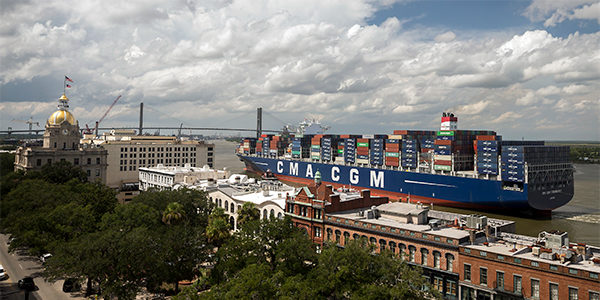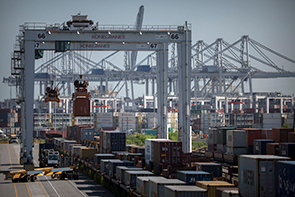The arc of the future?

In September 2016, the Georgia Ports Authority (GPA), the operator of the containerport of Savannah and the break-bulk and roll-on/roll-off port of Brunswick, announced it would construct an arc-like rail network stretching across the country's midsection. By building 97,000 feet of track linking the two rail yards at its Garden City container terminal, GPA would offer the two railroads that serve Savannah—Norfolk Southern Corp. (NS) and CSX Corp.—sufficient scale to assemble 10,000-foot unit trains to routinely run from Savannah's docks to markets as far west as St. Louis.
Nearly a year later to the day, the largest containership ever to call on the East Coast, the 14,000-TEU (20-foot equivalent unit) CMA CGM Theodore Roosevelt, docked at Savannah after sailing through the widened and deepened locks of the Panama Canal, which accommodates vessels nearly three times the TEU capacity of the canal's original design. (See photo above.)
The two events are interconnected. The $128 million "Mid-American Arc" project, expected to be fully operational by 2020 with the first phase set for completion in 2019, is GPA's attempt to get ahead of what some believe is a secular shift in U.S. goods movement. As larger containerships hit the water and the expanded canal handles more cargo bound for destinations east of the Mississippi, the reasoning goes, East Coast ports can expect to see steady increases in volumes. As a result, the landside infrastructure will face greater productivity pressure as more boxes hit the docks; GPA expects Garden City to annually handle 1 million rail lifts (each container moving on or off a railcar constitutes one lift) by the time the Arc is completed. Meanwhile, there will be challenges making timely deliveries off the ports by truck amid increased road congestion and a growing shortage of qualified commercial truck drivers. Overarching all of this is the task of providing efficient and timely freight movement to a U.S. population inexorably headed toward the 400 million mark.
The confluence of these trends will force massive change on the transport ecosystem, says Walter Kemmsies, head of the North American ports practice at Chicago-based real estate and logistics services giant JLL Inc. The freight network will morph into what will resemble a power grid composed of gateway and inland ports, railroads, and intermodal truckers, all tied together by advanced IT (information technology) systems that maritime users today can't begin to fathom, Kemmsies says. The ports, he adds, will serve as the "generating plants."
The Arc represents an opportunity for GPA to attract more Asian import business transiting the canal and to capture traffic that historically flows to Chicago, St. Louis, and other Midwest points from the Ports of Los Angeles and Long Beach, which remains the nation's busiest port complex but which is plagued by persistent congestion and delays. As GPA Executive Director Griff Lynch sees it, the canal is the catalyst for much that is yet to come.
"Five or 10 years ago, a project like the Arc would not have had legs" because Savannah then didn't have the volumes to justify the need, Lynch said in a recent interview.
Lynch says the Arc is less about capturing market share from East and West Coast ports than it is about minimizing supply chain friction amid growing freight volumes nationwide. "We want to insert ourselves into the supply chain—not as a chokepoint but as an accelerant," he said.
WEST COAST'S ENDURING STRENGTHGPA is not the only port authority inserting itself into the 21st century transport mosaic. This summer, the Port Authority of New York and New Jersey completed a $1.6 billion project to raise the Bayonne Bridge—which spans the two states—to 215 feet from 151 feet; the rise provides clearance for ships with 18,000-TEU capacities, doubling the maximum vessel size that could be handled before. The Virginia Ports Authority, which runs the Port of Norfolk among other facilities, has been involved for seven years with Norfolk-based NS's "Heartland Corridor" project that expedites double-stack intermodal traffic moving between Norfolk, Chicago, and Columbus, Ohio. In September, the port announced that CSX would link Norfolk and Pittsburgh in what would be the last step in the Jacksonville, Fla.-based railroad's decade-old "National Gateway" double-stack initiative.
Out west, Omaha, Neb.-based Union Pacific Corp. and Fort Worth, Texas-based BNSF Railway operate double-stack services on double-tracked infrastructure from the Southern California ports into the Midwest. Today, 16 unit trains, some two miles in length, run daily from Los Angeles to Long Beach and from there to Dallas, St. Louis, and Chicago.
Joshua Brogan, vice president at consultancy A.T. Kearney & Co., says the Los Angeles-Long Beach complex remains the most cost-effective way to move Asian imports into the U.S. heartland. Freight from Shanghai to Chicago transiting the West Coast arrives at its final stop in as little as 15 days, and 21 days at the very outset if there is significant congestion at the U.S. gateway, Brogan reckons. By contrast, freight on the same vessel transiting the Panama Canal, calling on Savannah, and trans-loaded onto rail for movement to Chicago takes 24 days to arrive, he says. The pricing differential between the two routes isn't significant enough to move the needle, he says.
Brogan says that despite the original canal's smallish size (5,500-TEU capacity), there wasn't much pent-up demand to shift business from the West to the East Coast even before the expansion. Other than a two-month dip in early 2017 for West Coast loaded box traffic, there hasn't been a meaningful decline out west since the expanded canal opened for business in June 2016, according to Kearney data gathered from the ports. This lends credence to the belief that there wasn't any latent demand for the expanded canal to satisfy, he says.
Comparisons between Savannah and the Los Angeles/Long Beach complex rarely arise in discussions with shippers and beneficial cargo owners (BCOs), Brogan says. "It's just not a major issue for them," he says.
ODDS-ON FAVORITEIf one believes, however, that competition among East Coast ports for burgeoning "neo-Panamax" traffic will be fierce, then Savannah holds a strong hand, experts say. Its 1,200-acre Garden City terminal is considered a model for landside operations, and it still has room to expand. All rail traffic exiting Savannah leaves from its docks. Even at Los Angeles and Long Beach, less than one-third of box traffic departs via on-dock rail, according to Jon Slangerup, former executive director of the Port of Long Beach and now executive chairman and chief executive officer of American Global Logistics, an Atlanta-based third-party logistics services and technology provider. The balance is still trucked to urban, near-dock truck-to-rail transload facilities, he says.
Slangerup says the Port of New York and New Jersey has issues in strengthening its IT systems connecting vessels, ports, rails, and trucks. It is also hobbled by the congestion that accompanies being in the country's most densely populated market. Savannah has the technology, it has the space, and it has a multimodal powerhouse just 250 miles to the west in Atlanta, which boasts the world's busiest airport for passenger volumes and is a major aircargo gateway.
While Virginia has components such as multimodal connectivity and inland port operations to optimize its network and keep pace with trade growth, it "doesn't have the infrastructure or push-pull effect of Atlanta to compete on the scale of Savannah," Slangerup says. The Port of Charleston, S.C., meanwhile, needs to get its "arms around the required capital" to position itself as a competitor to Savannah, he added.
Savannah also has another factor in its favor: its ownership. As one of four port-owned and -operated facilities—the others being Charleston, Norfolk, and Houston—it has the full support of the state, as well as access to state funding. By contrast, Los Angeles/Long Beach and New York/New Jersey, being so-called landlord ports, have to deal with often-conflicting objectives of terminal operators as well as multiple political masters.
At Savannah, the dearth of red tape means faster decisions and less time wading through the bureaucratic muck, says Kemmsies of JLL. The GPA's operational structure, he says, means it "can fix things before they're broken."
Related Articles

Copyright ©2024. All Rights ReservedDesign, CMS, Hosting & Web Development :: ePublishing
